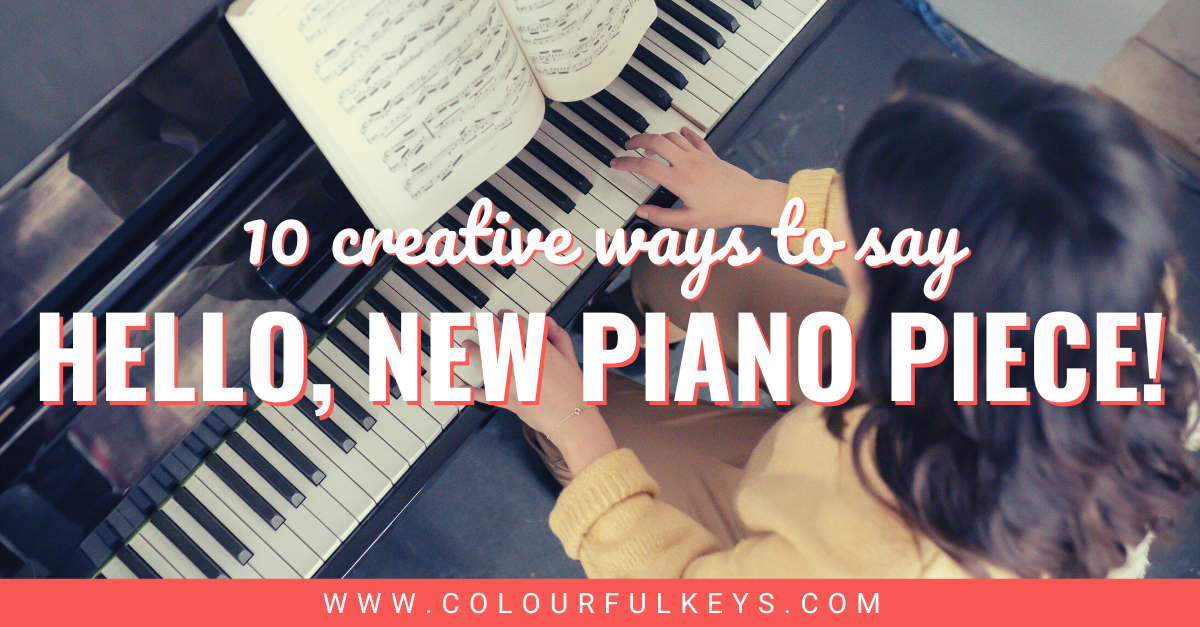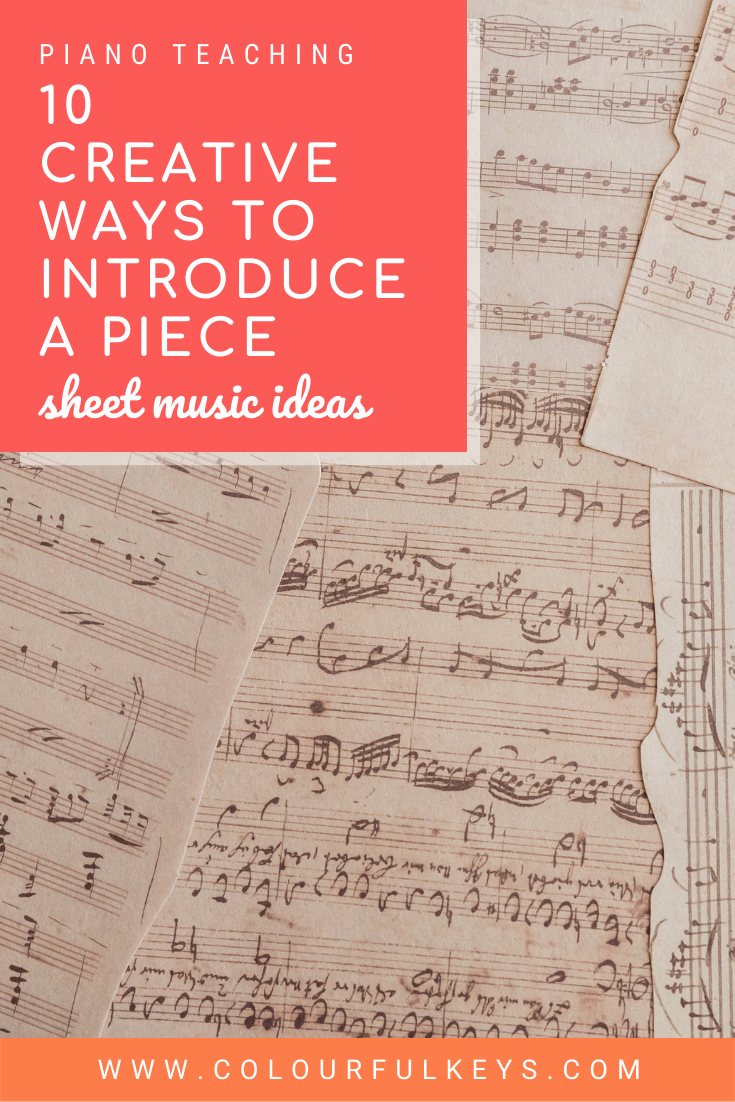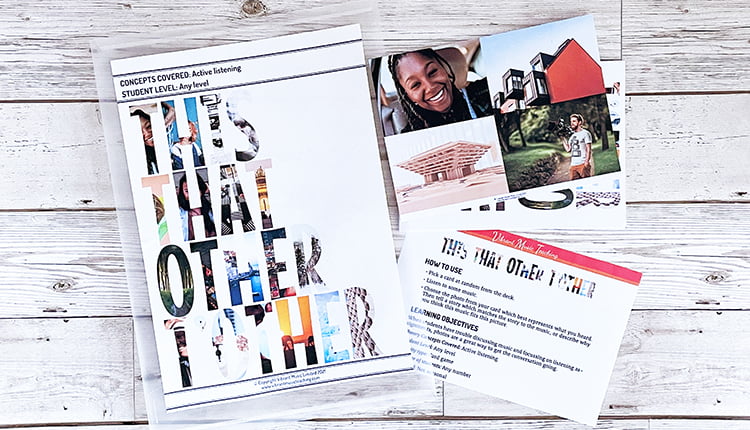
This post about getting creative when you introduce students to a new piano piece was written by Ben Kapilow. Ben is the Resident Music Director at the Media Theatre for the Performing Arts in Media, Pennsylvania, USA where he directs 5 – 7 musicals per year while also teaching piano, voice and songwriting to about 60 students. Ben hosts an interview podcast for piano teachers called ‘All Keyed Up’. Learn more at www.benkapilow.com.
Have you ever become great friends with someone while sitting across from them at a table, telling who they are by what they’re wearing and what they look like? Pretty unlikely! To truly know a person, we need to have shared experiences, give and take, ask questions and have fun together.
So how can we expect piano students to really “get” a new piece of music and fall in love with it by simply reading it from start to finish?

Learning a new piece of music is exciting, with the potential for discovery, adventure and new challenges.
Beginnings can draw us in and set the mood for whatever ensues.
Think of hearing the first few seconds of Beethoven’s 5th, listening to the opening montage in ‘The Lion King’ or even experiencing delicious aromas the second you enter the door of a restaurant.
In each of these cases, the beginning grabs your attention and instantly encapsulates the atmosphere you’re about to enter.
I believe the same idea applies to introducing a new piece of music. So here I’ll share 10 creative ways to introduce a new piece to your piano students.
But first…
How Not to Introduce a Piece
Before we dig into our creative introductions, I think it’s important to explore how not to present a student with a new piece (and don’t worry if you teach like this – I’ve made these same underwhelming introductions many times!)
Mistake No. 1: Measure by Measure
Picture this: A student starts with bar (measure) 1, agonising over getting the rhythm and notation correct before moving on to bar (measure) 2.
Sound familiar? Perhaps this was the way you were taught.

Going through the piece one measure at a time in chronological order doesn’t take the whole picture into account.
It’s also pretty boring.
An effective teacher creates a well-thought-out lesson that takes some kind of angle on the piece and uses it with a deliberate intention.
Mistake No. 2: By the Book
Exposing piano students to a concept when they experience it in repertoire – rather than before – sets them up for failure.
For example, if a method book piece introduces quavers (eighth notes), the teacher would read what the book has to say about quavers aloud. Then they’d ask the student to work through the piece while keeping that brand-new information in mind.
They haven’t even had time to process this new note value yet, much less internalise it.
Lessons work much more strongly when the teacher anticipates the next units in the book and preempts the upcoming ideas, taking a more active role in the learning process than merely sitting back and letting the book do all the work.
10 Creative Ways to Introduce a Piece
If you’re going to avoid those two ways of introducing a new piece, then you’ll need to have alternatives in mind.
Here are 10 creative introductions to keep at hand so you can use whichever seems the most appropriate for the piece and keep your students on their toes.
No. 1: Have Fun With Titles
In our interview on All Keyed Up, Marvin Blickenstaff explained that titles are one of the strongest ways to encourage students to be creative.
This is more difficult when working on pieces with generic titles such as ‘Sonatina in D’. But when teaching a piece with an interesting title, have your students brainstorm what they think the piece will sound like before looking at or hearing the music.

A great way to try this exercise is to lead students through improvisations based on the title and then compare the student’s improvisations with the music that the composer wrote.
The ‘Piano Safari’ method works especially well for these kinds of activities because so many of the pieces have fun titles, like ‘Hungry Herbie Hippo’ or ‘Zebra on a Pogo Stick’. Students love to brainstorm what sounds a composer might use to create those images.
VMT members: Remember to use your exclusive discount code to get 10% off all Piano Safari purchases!
No. 2: What makes a piece GOOD?
Traditional music theory analysis, like circling all of the skips or analysing Roman numerals, is important. But what if you took this one step further by talking about why the piece you are teaching is good?
Your goal in analysing repertoire shouldn’t be for your students to just understand pieces, but to like them.
I recently worked with a student on the theme from the movie ‘Up’, using it as an opportunity to reinforce our previous work on seventh chords. But instead of merely asking her to find all the 7th chords, I played her an alternate version where I replaced all the 7th chords with triads.
This made it easy for her to see how bland the piece would be without that all-important 7th which opened up the discussion as to why this piece sounded great.
No. 3: What’s the history?
I don’t mean just saying the date a piece was written or where a composer studied. I’m talking about the big-picture, historical trends that show up in the music.
If your piano students are learning a piece by Debussy, you could introduce the piece by showing them several impressionist paintings alongside earlier, more realistic-looking paintings and notice any differences.
Next, you could play the Debussy piece alongside a piece from the classical era, leading to a discussion about the overlap between impressionism in music versus impression in art.
Approaching music history with a bird’s-eye view makes it come to life much more than simply offering basic trivia about pieces and composers.
No. 4: Make the Listening “Active”
If you choose to introduce a new piece by playing it for your piano students, there are many ways to encourage active listening.
One way is to have them touch their nose (or do some other physical action) every time a certain motif appears.
You could even have your students match images to the mood of the new piece. This That Other t’Other would be a great resource to use for this listening activity.
If you need more inspiration, Orli Shaham’s ‘Bach Yard’ series frequently includes creative guided listening activities in her teaching.
In this particular episode, Shaham teaches students how to create a fish out of cardboard. The students then use the fish in various ways to respond to the musical elements in Schubert’s ‘Trout Quintet’.
No. 5: Get moving!
Movement activities allow students to experience music throughout their whole bodies. This could be asking your student to freely explore movements while listening to the piece, or it could be simply tapping the rhythmic notation via body percussion.
Nicola’s ‘Rhythm in 5’ has many different movement activities you can do in five minutes or less, helping students internalise rhythm concepts in ways that are effective, efficient and FUN!
VMT members can download ‘Rhythm in 5’ from the Vibrant Music Teaching library, and even take the step-by-step course where you can see exactly how the rhythm activities work in real-world teaching.
No. 6: Rote Teaching
Rote can be a great way to teach highly-patterned music and is an excellent way to introduce a piano piece to students.
While it’s great to have pieces that are specifically designed to be taught by rote, you can really combine teaching by rote and sight reading with any piece if there’s a section where you think it would be particularly effective.
Jeanine Jacobson’s ‘Professional Teaching Series’ describes a particularly compelling strategy of integrating rote and notation-based teaching by introducing students to portions of a piece by ear (or by rote) and then having the students identify that spot in the score.
No. 7: Sing the Melody
Get your students to sing, even if they are not strong vocalists.
It’s often easier to sing back a melody than sight read a melody, and singing helps students internalise the pulse, rhythmic feel and phrasing of a piece.
If the song has lyrics written in, the student can sing those. But if not, the singing can be on solfa, a neutral syllable or – if you’re feeling adventurous – you can make up some lyrics yourself.
I love creating silly lyrics on the spot that gets the student laughing when they sing along!
You can learn more about this in this excellent episode of Tim Topham’s Topcast.
Enter your info below and we’ll send you the Curwen hand sign posters you can use if you like to sing the melody with solfa.

Subscribe to updates and get the CURWEN HAND SIGN POSTERS
Enter your details to subscribe to the newsletter for piano teachers with information, tips and offers.
I hate spam as much as you do! I’ll only send you information that’s directly relevant to music teachers and you can unsubscribe at any time.
VMT members, you can download the posters instantly from the VMT Library. Not a member? A Vibrant Music Teaching membership isn’t just a collection of games. In addition to our printable library, members get instant access to loads of teaching videos, self-paced training courses, a full library of videos, an active community of teachers like you plus more resources than we can list here. Check it out today!
No. 8: Improvisation Springboard
Almost every possible concept contained within a piece can be explored through improvisation. Just to name a few:
- If a piece is in 3/4 time, then improvise in 3/4 time. If it uses the D five-finger position, improvise in D position.
- The student can play one phrase as written, and then improvise a second line.
- You can improvise a right hand over the written left hand, or vice versa.
Improvisation allows students to experience musical concepts from the inside out, just like learning a language by having spontaneous conversations. The next time you introduce a piece to your piano students, try starting with a bit of improv.
No. 9: Swap Roles
As an educator, you probably know that one of the best ways to learn something is to teach it. Why not have your student become the teacher?

This strategy is not only helpful for your student’s learning process, but it also allows you to see if they can independently work out the correct steps for learning a new piece.
Try this out by asking your student to take on the role of teacher. You, the student, make “mistakes” and see if your student can figure out a helpful plan to correct you.
You could make this activity lighthearted by making really silly mistakes or by pretending to be a character.
This exercise is particularly effective in buddy or group lessons where students can take turns playing the roles of student and teacher.
No. 10: Make it Relevant
Try drawing musical connections between unfamiliar pieces and the songs your students listen to at home. This can help students more vividly appreciate the music you assign them.
Many pop songs use musical techniques that are ubiquitous in pedagogical piano music, such as descending bass, sequences and syncopation (just to name a few.)
Here’s a specific example: When I’m trying to get a student to feel a piece in 12/8, I often incorporate pop songs like ‘Perfect’ by Ed Sheeran.
This activity can help students understand that music is music, whether it’s the music they hear on Spotify or music in their method books.
What are some of your favourite ways to introduce a piano piece to students?
Did I leave any out of my list? Let me know in the comments below.
For more ideas on teaching repertoire, check out Nicola’s centralised hub page devoted to Planning Lessons.

